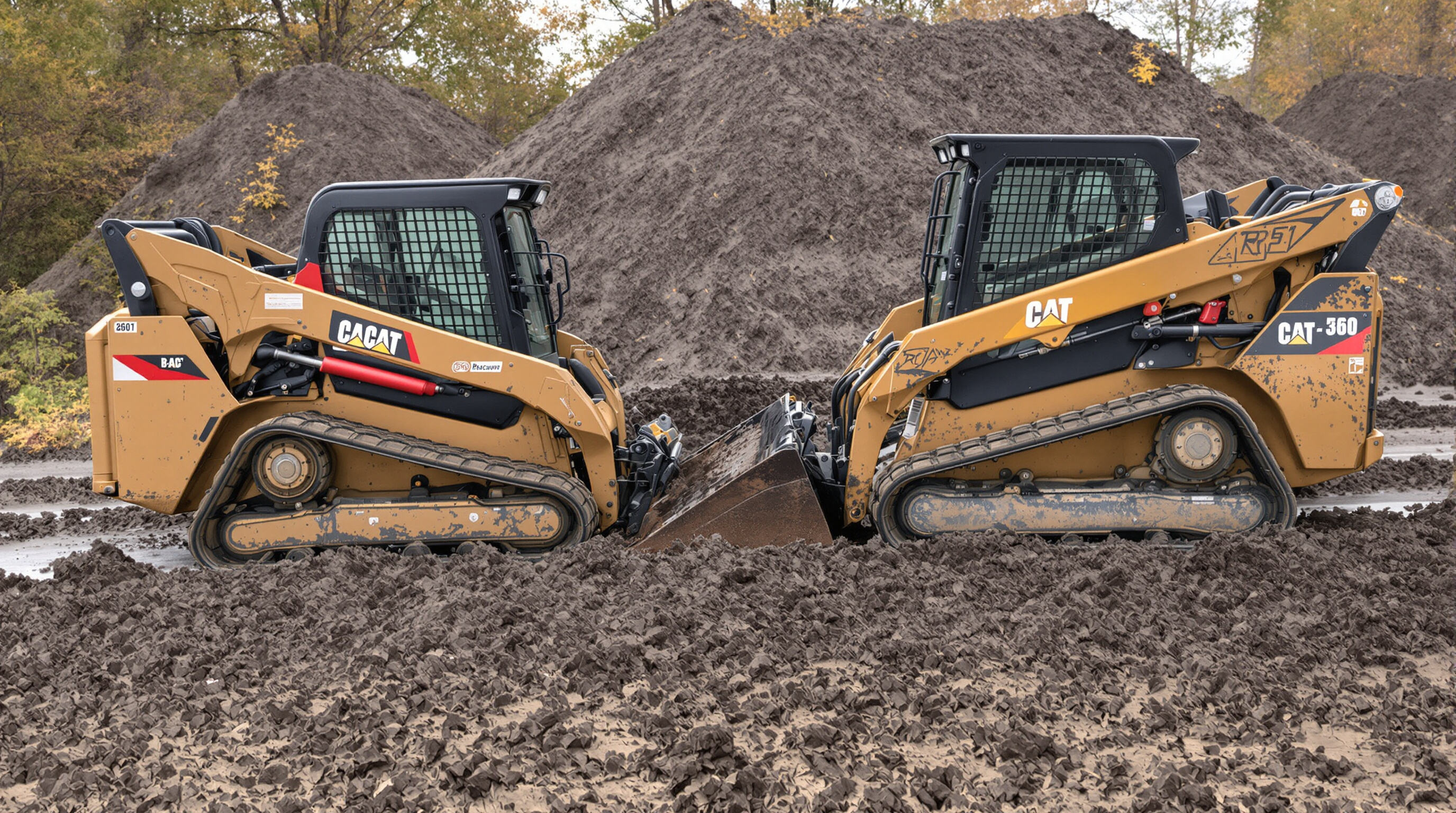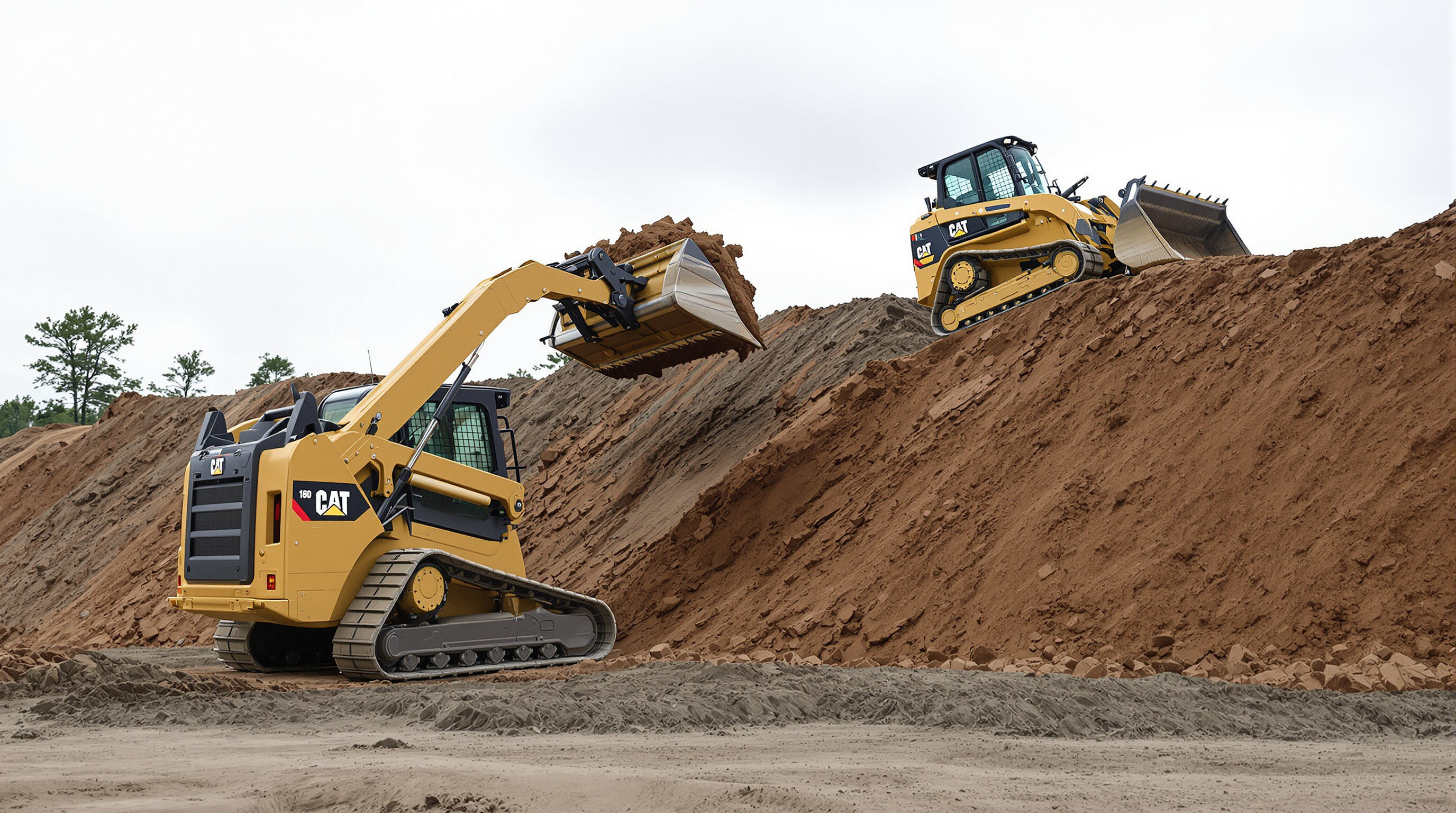Конструкция и сцепление: основные различия между погрузчиком с бортовым поворотом и компактным гусеничным погрузчиком

Основные различия в конструкции: колеса против гусениц
То, что действительно выделяет эти машины — это способ их передвижения. Мини-погрузчики с колесным ходом, в то время как компактные погрузчики на гусеничном ходу (CTL) вместо этого имеют резиновые гусеницы. Колеса отлично работают на дорогах или утрамбованной земле, так как они ближе к поверхности, что позволяет быстро поворачивать при необходимости. Гусеницы же рассказывают другую историю. Они распределяют вес машины гораздо лучше, чем колеса. Речь идет примерно о 80–90 процентах меньшего давления на поверхность земли. Это имеет решающее значение при работе на заснеженных участках или в грязных полях, где обычное оборудование просто утонет.
Сравнение тяги и давления на грунт
Гусеничные погрузчики создают давление на грунт около 5–7 фунтов на квадратный дюйм, распределяя свой вес по широким гусеницам. Погрузчики с фронтальным поворотом, напротив, создают давление от 30 до 45 psi непосредственно на небольшие колеса. Вот почему специалисты, работающие на заболоченных участках или пересечённой местности, предпочитают использовать гусеничные машины — они обеспечивают лучшее сцепление. Это подтверждается исследованием Heavy Equipment Traction Study 2024 года довольно убедительно. Однако на ровной поверхности колесная техника компенсирует это более высокой мощностью относительно своего веса. Она может двигаться примерно на 12–15 процентов быстрее при благоприятных условиях, что особенно важно при сжатых сроках или длительных переездах между строительными площадками.
Влияние на производительность на мягком, мокром и неровном грунте
Гусеницы помогают машинам оставаться на поверхности мягкой почвы, например, болотистой местности, не проваливаясь в нее. CTL (погрузчик с непрерывными гусеницами) продолжает уверенно работать там, где обычные погрузчики на колесах могут застрять и вообще не сдвинуться с места. При работе на склонах круче примерно пятнадцати градусов такие гусеничные машины обеспечивают примерно на двадцать два процента лучшую устойчивость при движении по склону, поскольку не скользят так сильно, как это делают колеса. Однако есть один важный момент, который стоит упомянуть. Колесная техника на самом деле лучше справляется с задачами, когда земля покрыта льдом. Проблема возникает из-за того, что лед может застревать между металлическими гусеничными пластинами, что снижает эффективность CTL примерно на восемнадцать процентов по сравнению со стандартными колесами, которые естественным образом очищаются при перекатывании по снегу или льду.
Маневренность и эксплуатационная эффективность в реальных условиях
Радиус поворота и маневренность погрузчика в ограниченном пространстве
Мини-погрузчики с поворотной рамой особенно эффективны при работе в стесненных условиях, поскольку они могут поворачиваться на месте. Некоторые модели действительно могут разворачиваться всего лишь на пространстве около 60 дюймов, что довольно удивительно, учитывая габариты этих машин. Операторы считают эту функцию очень полезной при перемещении по строительным площадкам в городе, внутри складов или по узким переулкам, где крупная техника просто не пройдет. Их ценят за способность полностью поворачиваться на месте, точно в пределах собственной площади машины. Это позволяет подрядчикам загружать и разгружать материалы даже на очень тесных участках при жилищных ремонтных работах, где обычная техника застряла бы или должна была бы выполнять множество неудобных маневров.
Производительность компактных гусеничных погрузчиков на чувствительных или пересеченных поверхностях
Компактные погрузчики на гусеничном ходу распределяют свой вес на более широкие гусеницы, что значительно снижает давление на грунт — с 15–20 psi, характерных для погрузчиков на колесном ходу, до 3–5 psi, согласно отчету Equipment World за прошлый год. Благодаря этой конструктивной особенности они могут устойчиво работать даже в сложных условиях — представьте себе илистые склоны, ледяную местность или особо чувствительные зоны, такие как газоны на полях для гольфа, где необходимо избегать повреждений любой ценой. В исследованиях, опубликованных в 2023 году, также было отмечено нечто интересное: гусеничные машины завершают работы примерно на 22% быстрее, чем традиционное колесное оборудование в дождливую погоду, просто потому что проскальзывание снижается и почва меньше уплотняется.
Пример из практики: применение на участке жилищного строительства со сложным рельефом
Застройщик, ведущий работы по новому жилищному проекту в центральной части Иллинойса, столкнулся с необходимостью построить дороги, не повредив при этом заболоченные участки, проходящие через участок площадью 50 акров. Для укладки асфальта и уборки строительного мусора в местах прокладки дорог использовались мини-погрузчики с гусеничным ходом, однако при перемещении тяжелых грузов по заболоченным участкам строители перешли на погрузчики с гусеничным приводом. Эти машины могли справляться с пересечённой местностью, не повреждая при этом чувствительную экосистему, находящуюся под ними. Некоторые исследования эффективности строительных работ показали, что комбинирование различных типов техники позволяет сократить расход топлива примерно на 17 процентов и уменьшить продолжительность проектных задержек примерно на треть, что обычно происходит, когда бригады используют только один тип оборудования для выполнения всех задач.
Грузоподъемность, устойчивость и производительность землеройных работ

Сравнение мощности и грузоподъемности
Что касается грузоподъемности, то между фронтальными погрузчиками с приводом на все колеса и компактными гусеничными моделями действительно есть разница. Погрузчики с вертикальным подъемом, как правило, могут поднимать груз на 15 и даже на 20 процентов выше, чем их аналоги, а на самых мощных моделях высота подъема может достигать впечатляющих 159 дюймов благодаря их конструкции. Но не стоит полностью исключать гусеничные погрузчики. Они способны выдерживать больший вес при полностью выдвинутой стреле, обычно обеспечивая оператору на 10–15 процентов большую грузоподъемность, поскольку гусеницы равномернее распределяют вес машины по поверхности земли. Согласно последним данным из отчета CEMA Equipment Performance Report за прошлый год, средняя грузоподъемность гусеничных погрузчиков составляет около 2850 фунтов, тогда как у компактных колесных погрузчиков аналогичного размера этот показатель составляет всего около 2450 фунтов. Вот почему на некоторых строительных площадках отдают предпочтение одному типу техники перед другим, в зависимости от того, что именно нужно перемещать.
Устойчивость и рабочие характеристики на склонах и неровных поверхностях
Гусеничные погрузчики создают на поверхность земли давление на 30–50 % меньше, чем фронтальные погрузчики с поворотной рамой, что делает их значительно более безопасными при работе на крутых склонах, иногда даже до 30 градусов. Более широкая опорная поверхность гусениц также способствует устойчивости машины. По данным исследований, проведённых Caterpillar в 2022 году, их гусеничные машины сохраняли в ковше около 89 % груза при работе на склонах, тогда как колёсные аналоги удерживали только около 67 %. Погрузчики с поворотной рамой компенсируют это меньшим радиусом поворота, особенно на ровных покрытиях, где они могут развернуться за четыре секунды и менее.
Эффективность землеройных работ по типу техники
При работе в сложных условиях, например, при рытье в плотной земле, экскаваторы-погрузчики с гусеничным ходом действительно показывают хорошие результаты на продолжительных работах, перемещая примерно на 20% больше материала в час, если верить данным AEM за прошлый год. При этом погрузчики с фронтальным поворотом всё же лучше экономят топливо, потребляя примерно на 1,3–1,4 галлона меньше в час при выполнении быстрых операций на твёрдом грунте. В современных моделях обеих машин всё чаще устанавливают интеллектуальные гидравлические системы, которые автоматически подстраиваются в зависимости от массы поднимаемого груза. Эта технология сокращает продолжительность каждого цикла примерно на 12–15%, а также способствует общей экономии топлива, чему производители уделяют особое внимание в последнее время.
| Особенность | Skid loader | Компактный гусеничный погрузчик |
|---|---|---|
| Среднее значение ROC на максимальной высоте | 950–1180 кг | 1130–1450 кг |
| Устойчивость на склоне | ≤ 25° | ≤ 30° |
| Расход топлива (в час) | 10,6–13,2 л | 12,1–15,5 л |
| Сдвиг материала (рыхлый грунт) | 85–110 ярдов³/ч | 100–135 ярдов³/ч |
Данные взяты из отчета CEMA по землеройной технике за 2023 год
Стоимость владения: фронтальный погрузчик с боковым разгрузом против компактного гусеничного погрузчика
Начальная цена покупки и долгосрочная ценность
Фронтальные погрузчики с боковым разгрузом обычно стоят примерно на 15–30 тысяч долларов дешевле аналогичных компактных гусеничных погрузчиков (КГП), если покупать их новыми, что делает их привлекательными для тех, кто внимательно следит за бюджетом. Однако здесь есть нюанс: если предполагается регулярное использование на мягком грунте или неровных поверхностях, компактные гусеничные погрузчики окупаются лучше в долгосрочной перспективе. Согласно исследованию техники за прошлый год, операторы КГП сталкивались примерно на 38% реже с задержками проектов, вызванными плохими дорожными условиями, при строительстве жилых домов. Такая эффективность, как правило, компенсирует дополнительные затраты на покупку такого оборудования в течение трех–пяти лет регулярного использования.
Обслуживание, расход топлива и эксплуатационные расходы
Счета на обслуживание машин CTL обычно на 40–60% выше, чем у другого оборудования, поскольку эти гусеницы необходимо заменять каждые 1000–1500 часов работы, не говоря уже обо всех сложных деталях, находящихся внизу. Что касается расхода топлива, то погрузчики с бортовым поворотом также имеют преимущество, потребляя на 5–10% меньше дизельного топлива при выполнении аналогичных работ. Но есть и другой аспект, который стоит учитывать. Несмотря на более высокую начальную стоимость, CTL могут экономить деньги в долгосрочной перспективе, так как их гусеницы создают давление на грунт примерно на 35% меньше. Это означает, что ландшафтным дизайнерам не придется ремонтировать поврежденные участки газонов или чинить трещины в покрытии после перемещения тяжелых материалов во время проектов.
Парадокс отрасли: более высокая стоимость гусеничных погрузчиков против адаптивности к местности
Мини-погрузчики отлично работают на твердом покрытии, но при выполнении работ на участках со смешанным рельефом подрядчики фактически сталкиваются с эксплуатационными расходами на 27% ниже в час при использовании гусеничных мини-погрузчиков (CTL). Причина? Эти машины CTL продолжают эффективно работать даже в сложных условиях, таких как грязь, снег или мягкий грунт, где мини-погрузчики с бортовым поворотом испытывают трудности с устойчивостью. Согласно недавнему отраслевому исследованию 2024 года, операторы CTL завершали земляные работы примерно на 22% быстрее, чем их коллеги на мини-погрузчиках, при работе на склонах круче 15 градусов. Понятно, почему все больше компаний начинают переходить на использование CTL для подобных проектов.
Перспективные направления развития технологий погрузчиков с бортовым поворотом и компактных погрузчиков на гусеничном ходу
Электрификация и интеллектуальные системы управления в компактной технике
Электрические мини-погрузчики и компактные гусеничные погрузчики в последнее время становятся все более распространенными, в основном благодаря улучшенным литиевым батареям и более быстрым зарядным станциям, которые появляются повсюду. Согласно отраслевым отчетам за конец 2024 года, к концу этого десятилетия около 35 процентов всех продаж нового оборудования будут приходиться на электрические модели, особенно для работ в городах, где важны жалобы на шум и требуется нулевой уровень выбросов. Новые машины оснащены телематическими системами, которые позволяют операторам следить за всем: от состояния батареи до уровня гидравлического давления и эффективности навесного оборудования. И есть еще одна особенность — интеллектуальные уведомления о техническом обслуживании на основе искусственного интеллекта сократили непредвиденные поломки почти на четверть, согласно некоторым исследованиям прошлого года.
Обзор инноваций ведущих производителей
Крупные производители оборудования уже начали уделять внимание модульным конструкциям, которые позволяют легко интегрировать системы грейдинга с GPS и функции автоматического обнаружения навесного оборудования. Обратите внимание на последние модели гибридных дизель-электрических машин — испытания показывают, что они потребляют на 30 процентов меньше топлива во время длительного простоя, что имеет большое значение для задач, таких как обслуживание дворов или уборка снега. Экологические инициативы также влияют на производство этих машин. Сейчас мы наблюдаем увеличение использования переработанной стали и гидравлических жидкостей растительного происхождения в реальных производственных сериях. Цель здесь заключается не только в улучшении эксплуатационных характеристик на различных типах грунта по сравнению со старыми гусеничными транспортными средствами, но и в опережении постоянно ужесточающихся экологических норм, которые становятся все строже год за годом.
Часто задаваемые вопросы
Каковы ключевые различия между мини-погрузчиком с фронтальным захватом и компактным погрузчиком на гусеничном ходу?
Основные различия заключаются в их механизмах передвижения. Мини-погрузчики на колесном ходу идеально подходят для твердых покрытий. Мини-погрузчики на гусеничном ходу используют гусеницы, которые лучше распределяют вес и обеспечивают повышенное сцепление на мягких, илистых или неровных поверхностях.
В каких ситуациях предпочтительнее использовать мини-погрузчик на колесном ходу, чем мини-погрузчик на гусеничном ходу?
Мини-погрузчики на колесном ходу превосходны на твердом грунте или в городских условиях, где требуется высокая маневренность, например, на городских строительных площадках или в жилых районах, благодаря своей способности быстро поворачивать.
Как сравнивается стоимость обслуживания мини-погрузчика на колесном ходу со стоимостью обслуживания мини-погрузчика на гусеничном ходу?
Как правило, мини-погрузчики на колесном ходу дешевле в обслуживании, так как они имеют меньше движущихся частей и не требуют регулярной замены гусениц, в отличие от мини-погрузчиков на гусеничном ходу.
Оправдывает ли компактный гусеничный погрузчик более высокую первоначальную стоимость?
Хотя мини-погрузчики с гусеничным ходом изначально стоят дороже, их способность справляться с пересечённой местностью и сокращать задержки проектов могут сделать их более экономичными в долгосрочной перспективе, особенно при частом использовании вне дорог.
Какие будущие тенденции можно ожидать в технологиях погрузчиков?
Технологии погрузчиков движутся в сторону электрификации и интеллектуальных систем управления. В будущих моделях, вероятно, будут применяться улучшенные аккумуляторные технологии и телематика, что повысит эффективность и сократит общий уровень выбросов в соответствии с экологическими нормами.
Содержание
- Конструкция и сцепление: основные различия между погрузчиком с бортовым поворотом и компактным гусеничным погрузчиком
- Маневренность и эксплуатационная эффективность в реальных условиях
- Грузоподъемность, устойчивость и производительность землеройных работ
- Стоимость владения: фронтальный погрузчик с боковым разгрузом против компактного гусеничного погрузчика
- Перспективные направления развития технологий погрузчиков с бортовым поворотом и компактных погрузчиков на гусеничном ходу
-
Часто задаваемые вопросы
- Каковы ключевые различия между мини-погрузчиком с фронтальным захватом и компактным погрузчиком на гусеничном ходу?
- В каких ситуациях предпочтительнее использовать мини-погрузчик на колесном ходу, чем мини-погрузчик на гусеничном ходу?
- Как сравнивается стоимость обслуживания мини-погрузчика на колесном ходу со стоимостью обслуживания мини-погрузчика на гусеничном ходу?
- Оправдывает ли компактный гусеничный погрузчик более высокую первоначальную стоимость?
- Какие будущие тенденции можно ожидать в технологиях погрузчиков?


